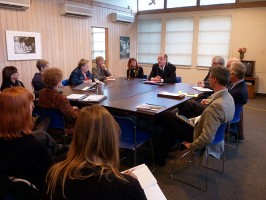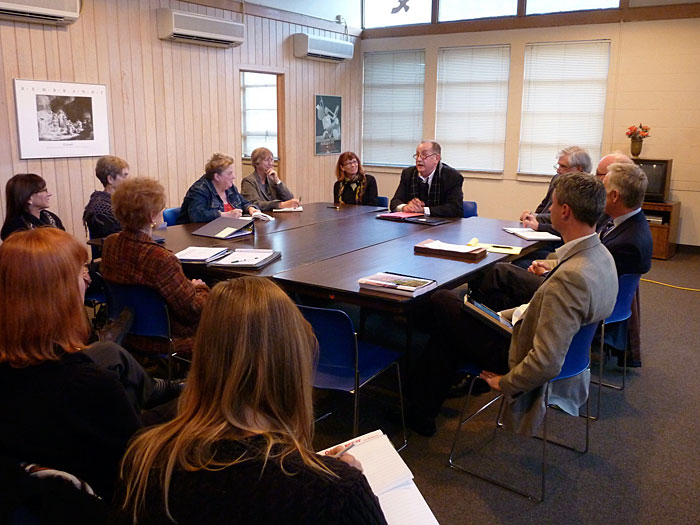At a November meeting George Neubert, director of the Flatwater Art Foundation spoke to the Board of Directors of the Springfield Art Museum about creating a vision statement for the art museum to aid in the search for a new director.
You are at one of the most critical and important points in the history of this institution. You have the responsibility to choose the next director to provide the leadership for the future. What a wonderful challenge – what an opportunity!
You should create a Vision Statement. That statement should be compiled by the shareholders — you first as trustees, and you should include the museum staff, donors and patrons, city administration, and the larger community. That Vision Statement will give you a clearer understanding of the person you want to hire.
George Neubert
director of the Flatwater Art Foundation
formerly director of San Antonio Art Museum, director and chief curator for Oakland Museum, associate director for the San Francisco MOMA, and consultant to the White House and Smithsonian Institution
Neubert has over 40 years art museum management experience including previous positions as director of the San Antonio Museum of Art, director of the Sheldon Art Gallery (now the Sheldon Art Museum) at the University of Nebraska-Lincoln, director of the Oakland Museum, and associate director of the San Francisco Museum of Modern Art. He also has served as consultant to the White House sculpture gardens and to the Smithsonian Institute and speaks nationally about public art policy and placement, exhibition development, and architectural landscape master-plan design.
 Neubert was in town at the request of Springfield artist Russ RuBert, who served for many years with Neubert on the board of the International Sculpture Center, publisher of Sculpture Magazine. RuBert said he attended a panel discussion that featured several prominent museum directors who discussed best practices for museums that Neubert moderated at an ISC sculpture conference several years ago, and after that, he hoped someday to bring some of those ideas back to the Springfield.
Neubert was in town at the request of Springfield artist Russ RuBert, who served for many years with Neubert on the board of the International Sculpture Center, publisher of Sculpture Magazine. RuBert said he attended a panel discussion that featured several prominent museum directors who discussed best practices for museums that Neubert moderated at an ISC sculpture conference several years ago, and after that, he hoped someday to bring some of those ideas back to the Springfield.
During his two-day visit to Springfield, Neubert toured the museum facilities and grounds, met with staff, made an informal assessment of the museum’s collection, and attended the Prints USA opening reception. He also consulted with other community arts administrators, faculty, and artists at a “Meet and Greet” event at RuBert Studios and toured the Creamery Arts Center, Drury University’s Pool Art Center, and the historic C-Street arts district.
A review of his findings and recommendations were presented verbally at the SAM Board of Directors meeting on November 18th and will be sent in written format to the board and Assistant City Manager Colin Quigley, who is currently acting director for the museum.
Neubert’s visit and consulting fees were funded in part by contributions of over $2,200 by private individuals to the Friends of the Art Museum. In honor of his visit, Russ and Pam RuBert also donated a Ralph Lanning stone sculpture to the Flatwater Folk Art Museum.
Highlights from the public meeting during which Neubert reviewed his findings and recommendations are as follows:
The Four Pillars of a Museum
- Collection of objects
- Preservation of objects
- Research or scholarship on and around those objects, including publishing a website, catalogs, and labels
- Exhibition
Education and outreach
Besides the four pillars, a museum has an obligation to fill the interpretive role, and an extension of research is education. Sharing information with the community is done through museum tours, publications, and educational programs, and to get the community to participate will require promotion and marketing.
The Current Strengths of the Springfield Art Museum
- community – there is a larger community that wants to be involved with the museum and has wonderful pro-active ideas to contribute
- museum collection – it is encyclopedic which will allow the display a variety of exhibits about cultures around the world
- print collection – a strong collection due to a long history of purchases and donations and could be enhanced by adding more historical and regional items to the collection
- staff – a highly experienced and committed staff, most of whom are willing to contribute even more to the museum’s mission
- facility – a top-notch centrally-located facility with beautiful galleries and an auditorium that could be used to build partnerships with other community arts organizations
- funding – the blessing of historical and consistent financial support by the city
- volunteers – an eager set of volunteers in the SMMA and Friends of the Art Museum who contribute financial support and want to become more involved
Current Short-comings of the Springfield Art Museum
- collection – the collection is under-utilized and needs to be more accessible to a variety of outside professionals, educators, and the public
- facility – under-utilization of the auditorium, courtyard, and the grounds which could be a wonderful outdoor gallery that connects the museum to the outside Neo-classic amphitheater with Greek columns and could be used for changing outdoor sculpture exhibitions and activities in the adjacent city park
- information technology – almost non-existent and needs to be addressed immediately. The collection needs to be inventoried and digitally accessible so that individuals could access, for example, the curator’s Top 100 with an image, artist’s name, and information. Information about the collection should used for promotion, education, and to build on museum activities.
- partnerships and collaborations – there exists a community of organizations in Springfield that have common interests and goals that should be tapped into, and partnerships with these groups would not cost anything
- community outreach – the museum needs to engage the community, involve the community, and develop community participation
- signage – is inadequate and out-of-date on the outside of the building and on the street
- logo and branding – inconsistent materials currently are being distributed, and the museum needs a consistent logo for all public relations materials. Everything sent out from the museum should be immediately identifiable.
- communication – needs to be improved. The museum is a public institution so not only in terms of fiscal responsibility, but also the moral obligation to the collection and mission of the institution, it needs to be sharing in terms of mission, goals, and objectives. Not only through information technology, but also in terms of personal communication between the staff, board members, and the community. For instance at each board meeting, a member of the staff including everyone from curators to custodians should have the opportunity to pick one thing out of the collection and briefly explain the meaning and personal significance to them. At the end of a year or two, everyone will have a much better and more personal understanding of the collection.
Visual Literacy
Visual Literacy is fundamental for communication and will be essential for success in the technological and informational world of the 21st century. The museum collection is one of the best ways to teach visual literacy. Exposure to works of art has the ability to alter our vision, expand our perspective of the world, provide new insights and understanding that is not possible through the traditional educational experience.
A work of art serves as a linkage of the human continuum — past to present, present to future. Cultural artifacts must be experienced and understood as both a physical object and an event in time. As an event in time, they carry numerous complex attributes implying intellectual, spiritual, social, philosophical and scientific records of experience and speculation that are unique to the time and place of creation.
Exposure to works of art helps to expand our repertoire of ideas, showing us what we have in common and increases our respect for individual diversity. Equally important, being exposed to works of art helps to develop the skill of making choices about the aesthetic experience, which advances culture.
In the world today, making choices is essential for success, and looking at art is one of the most powerful and subtle ways to learn to make choices. This is important to communicate to the business community – the education community already knows that people who go to art museums test higher and learn better.
What Kind of Person Should be Sought?
Once the board has the vision statement, it will help determine the qualities of the person that is desirable. Credentials, professional record, experience — these are commonly sought qualities that are desirable and can be assessed about each person.
Equally important is looking at the accomplishments that are part of a proven record and the characteristics of the person being sought. There is something that is hard to describe as “personality.” Is the person a team player? Can the person motivate a creative productive staff? Can that person communicate well?
In terms of communication, can that person express the special role and mission of the institution? Can he or she talk to a business leader and communicate the importance of culture and art and why it is an asset to the business community? He or she should also be able to talk to teachers in the schools, and let them know the importance of the museum. That doesn’t mean telling different stories, but for different individuals, the same story needs to be told using a bit different language to communicate the same idea.
So communication and passion are important, but also integrity — because if a leader doesn’t have integrity then the community won’t commit to the organization. That kind of trust that a person is going to back up what they say takes time to build.
Museum Accreditation
Neubert recommended that the new director be or become a member of the Association of Art Museum Directors. He also said the Springfield Art Museum should work to become accredited by the American Association of Museums, which he said should not be a problem based on his findings. Assistant City Manager Colin Quigley said he thought that the city has already started that process.
Is the Museum Director Position an Attractive One?
In answer to a question from the audience, Neubert said based on the current climate of fund-raising for private museums and the strong assets the Springfield Art Museum has to offer, it is a good time to have the position open. He said the strong assets of the museum such as stable funding and a good museum collection, combined with the support of volunteer associations and creative energy in the surrounding community — these assets combined with a clear vision statement for the museum should make the position very attractive to a number of qualified individuals.
